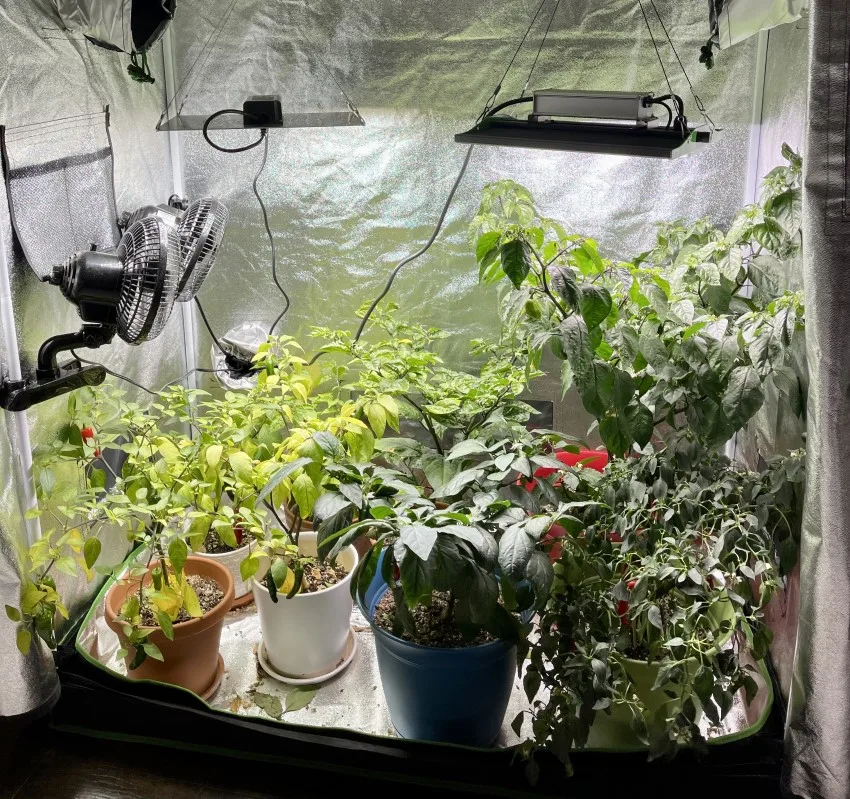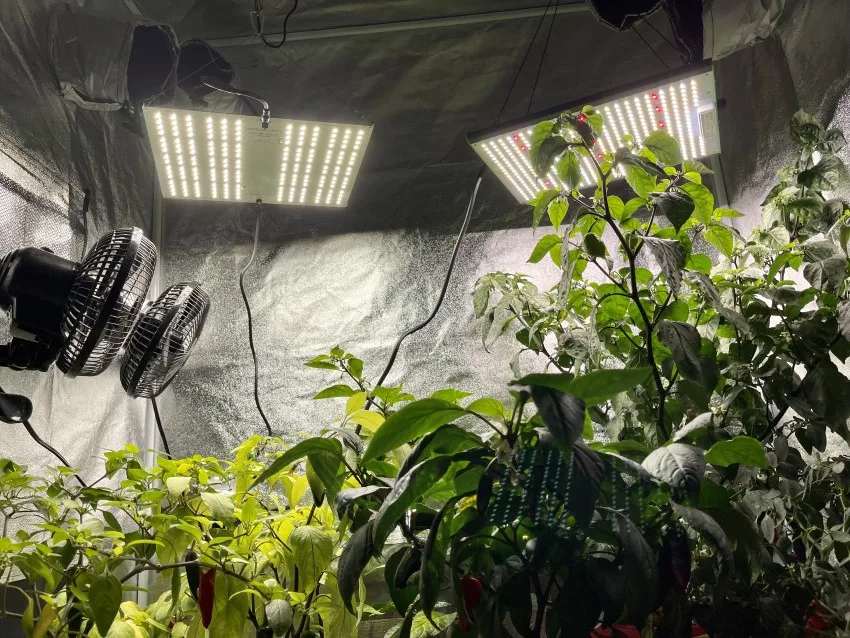Grow tents are a convenient, all-in-one solution for indoor gardening. They help gardeners create a controllable environment for their plants to flourish. While they are a great way to control the environment for your plants, they can also be susceptible to pests, so care needs to be taken to keep them out.
To control pests in your grow tent, keep it clean and debris-free. Inspect all your plants for insects before introducing them to your grow tent. and use sticky traps to catch flying insects.
With a little effort, you can keep pests under control in your grow tent and create a healthy environment for your plants. Read on to learn more about how to prevent pests in your grow tent using organic and inorganic methods, as well as the different types of pests that can invade your grow tent.

How to Prevent Pests From Getting Into Your Grow Tent
Pests can quickly wreak havoc in your grow tent when left unchecked. Your once vigorous, healthy plants can become weak and sickly and turn into eyesores. Luckily, there are several organic and inorganic ways to prevent pests from getting into your grow tent in the first place.
Organic Ways To Keep Pests Out of Your Grow Tent
If you are cautious about using chemicals in your grow tent, there are several organic ways to keep pests out.
Keep Your Grow Tent Clean and Debris Free
Pests thrive in dirty, cluttered environments. They love to hide in the nooks and crannies of grow tents and can quickly reproduce in the right conditions. To prevent them from taking up residence in your grow tent, keep it clean and free of debris.
This process means sweeping up any fallen leaves or dead plants and removing any unused pots or containers. Keeping your grow tent clean will also help you to spot pests early on so you can take action to get rid of them.
Inspect Your Plants Before Introducing Them to Your Grow Tent
One way pests find their way into grow tents is by hitching a ride on new plants. Before introducing new plants to your grow tent, scrutinize them for any signs of pests. Look for eggs, larvae, or adult bugs. It would help if you also looked for any webbing or damage to the leaves.
If you see any insects or eggs on the plant, remove them and dispose of them immediately. Quarantine new plants for a week or two to ensure they are not harboring any pests before adding them to your grow tent.
It’s also an excellent idea to source your plants from reputable growers to reduce the risk of introducing pests to your grow tent.
Companion Planting
Companion planting is growing plants near each other that benefit from each other’s presence. Some plants produce chemicals that repel pests, while others attract beneficial insects.
For instance, planting basil near your tomato plants will help to keep aphids away while attracting beneficial predators like ladybugs. Marigolds also produce a chemical that repels many common garden pests. When done correctly, companion planting can also help suppress weeds.
Use Beneficial Insects
If you have your grow tents sitting outside in your backyard, then beneficial insects can be a great way to control pests in your grow tent naturally. Ladybugs, for example, are voracious predators of aphids and other small, soft-bodied insects. Green lacewings are also effective predators of aphids, whiteflies, and caterpillars.
You can purchase beneficial insect larvae online or from your local gardening store. Introduce them to your grow tent, and they will go to work controlling the pest population. Again, this might be a good solution for grow tents that are kept outdoors, but may not be great for indoor grow tents, unless you’re okay with living with ladybugs!
Use Diatomaceous Earth
Diatomaceous earth is a natural substance made from the fossilized remains of algae. It is safe for humans and animals but deadly for insects.
The sharp edges of the diatomaceous earth particles cut into the insect’s body, causing it to dehydrate and die. You can apply diatomaceous earth to the soil around your plants or create a barrier with it to keep pests from getting into your grow tent.
Organic Pesticides
If you do decide to use pesticides in your grow tent, there are a variety that are organic and safe for use around food crops. Neem oil is a natural pesticide that is effective against aphids, whiteflies, and other small insects. It works by disrupting the insect’s life cycle and preventing it from feeding or reproducing. You can buy neem oil at your local gardening store or online.
Insecticidal soap is another organic pesticide that is safe for use around food crops. It works by suffocating the insects they come into contact with the soap. You can make your own insecticidal soap by the following easy steps:
- Mix one part organic dish soap with two parts water and pour into a spray bottle.
- Spray it directly on the pests, being careful to avoid getting it on the leaves of your plants.
For more on this, check out our post on organic pesticides.
Inorganic Ways to Keep Pests Out of Your Grow Tent
If you don’t mind using chemicals in your grow tent, there are several inorganic ways to keep pests out.
Chemical Pesticides
Chemical pesticides such as pyrethrin-based pesticides are effective against many insects, including aphids, whiteflies, and caterpillars. They work by paralyzing the insect’s nervous system, causing it to die.
While pyrethrin-based pesticides are relatively safe for use around food crops, they can be lethal to the plants when misused. Follow the manufacturer’s instructions carefully, and only use the pesticide when necessary.
Insect Smoke Bombs and Foggers
Insect smoke bombs and foggers release a thick cloud of toxic smoke that suffocates the pests it comes into contact with the toxin. They are effective against spider mites, fungus gnats, and other small insects.
However, they are also dangerous to humans and animals, so it is essential to use them cautiously. They are available in different sizes, so make sure you get one that is appropriate for the size of your grow tent, and that is safe for the plants that you are growing.
Insect Growth Regulators
Insect growth regulators (IGRs) are chemicals that prevent insects from reproducing. They work by disrupting the normal development of the insect rather than killing them outright. For instance, they can prevent immature caterpillars from reaching adulthood and reproducing by interfering with their molting process.
You can purchase them online or from your local gardening store. Unfortunately, IGRs can also affect beneficial insects, so use them cautiously.

Types of Pests That Can Invade Your Grow Tent
Before controlling pests in your grow tent, you must know what pests you may encounter so you can be the most effective in getting rid of them. When left unchecked, pests can quickly destroy your plants and ruin your entire crop. Some of the most common pests that invade grow tents include:
Aphids
Aphids are tiny, soft-bodied insects that suck plant sap. They can be green, yellow, black, or brown, and you will often find them in large groups on the undersides of leaves.
Aphids can reproduce quickly, and their populations can explode in weeks. They also produce a sticky substance called honeydew, which can attract other pests and cause sooty mold to grow on your plants.
Thrips
Characterized by their long, thin bodies, thrips are tiny, winged insects that feed on plant sap. They also scrape the surface of leaves, flowers, and fruits, feeding on the released juices.
Thrips are brown, black, or yellow, depending on the species. Under a heavy infestation, they cause premature wilting, delay leaf development, and distort the leaves. Thrips are also vectors of disease-causing bacteria, fungi, and viruses.
Whiteflies
Closely related to mealybugs and aphids, whiteflies are small, white-winged insects that feed on plant sap. They lodge themselves on the undersides of leaves and suck the plant sap, weakening the plant and causing the leaves to go yellow. Whiteflies also produce honeydew, which can attract other pests and cause sooty mold to grow on your plants.
Fungus Gnats
Fungus gnats are small, winged insects that primarily attack indoor plants. They are attracted to the damp, humid conditions common in grow tents. Fungus gnats lay their eggs in the soil, and the larvae feed on plant roots and organic matter.
This feeding can damage the roots and make the plant susceptible to disease. The adults also feed on plant sap, weakening the plant further.
Snails and Slugs
Common in damp, humid environments, snails and slugs are another type of pest that can invade your grow tent. These slimy creatures feed on leaves, stems, and flowers and leave behind a slime trail that can attract other pests. They can also spread diseases to your edibles, such as rat lungworm disease.
Spider Mites
Spider mites are tiny arachnids that feed on plant sap. They are common in warm, dry environments and can reproduce quickly. Spider mites attach themselves to the undersides of leaves, but in high infestation situations, they appear as clusters of yellow spots on the upper side of leaves.
They also spin webs that anchor them to the leaves and lay their eggs. As they feed, spider mites suck the chlorophyll out of the leaves, causing them to turn yellow or brown.
Grasshoppers
While they are more common in outdoor grow operations, grasshoppers can also find their way into grow tents. These voracious pests feed on leaves, stems, and flowers. They are particularly fond of young plants. A single grasshopper can eat its weight in vegetation daily, and a group can quickly decimate a crop.
Final Thoughts
Pests can be a huge deterrent to a successful grow tent operation, by damaging your plants, spreading disease, and reducing your yields.
Luckily there are several organic and inorganic ways to keep them under control. Try out a few of the above methods, and see what works best for you. Remember to use caution when using inorganic pesticides, and always follow the manufacturer’s instructions.
